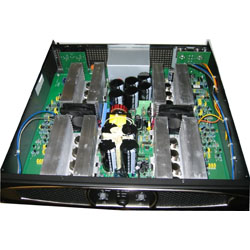
Bipolar transistors are positive temperature coefficient. When a transistor passes power, it heats up.
When a Bipolar transistor gets hotter its internal resistance decreases and tries to pass more power making it even hotter.
Because no two individual devices are identical, a positive coefficient means that one transistor tries to “hog” the load and tries to do all of the work.
To prevent this, large Emitter resistors are placed in the current path to help equal the sharing of the load.
If the heat is not controlled by temperature sensing devices thus reducing the drive of the output stage, thermal runaway will occur, thus blowing up the device.
The real “shocker” comes with failure. When a Bipolar fails, it tends to short, connecting the supply rail directly to the output.
When this happens you will experience the catastrophic effect causing all devices in parallel with the bad device also to short.
Have you ever experienced the “your amp went DC” diagnosis? Lets hope not! If you haven’t, your lucky, because when this happens whatever is connected to the output (i.e. loudspeakers) is also history.
In most designs there are DC sensing circuits incorporated to shut the channel or amp off. In most cases, however, these circuits aren’t fast enough to prevent serious speaker damage caused by thermal runaway.
How Can Negative Be Positive?
MOSFET Transistors are negative temperature coefficient. When a MOSFET heats up the internal resistance increases causing it to pass less power.
MOSFET amplifier designs are inherently thermally stable without additional circuitry and by nature has no chance of thermal runaway.
Each output device in effect self regulates to carry the load equally with all of the other output devices. When a MOSFET fails it usually opens, so there is rarely a chance of damaging a speaker from output stage failure.
This means there is no real need for additional thermal tracking and DC sensing circuitry.
Many designers that feel MOSFETs, if not matched properly, may be unnecessarily paralleled without the use of large (physical size) source resistors to equalize the current draw between devices.
As such, MOSFETs have no advantage over Bipolars in relation to space and cost reduction of expensive Emitter resistors for Bipolar circuits and Source resistors of MOSFET circuits.
MOSFET amplifiers have a much higher slew rate than Bipolar designs. MOSFET devices are very fast and can switch several amps in nanoseconds. This speed makes them thirty to one hundred times faster than equivalent Bipolar devices.
If you are accustomed to listening to traditional Bipolar designs and compare them to the speed of MOSFET design, you will notice a significant, almost unnatural audible difference in the HF. Such clarity is a pleasant added experience.
Engineer Wayne Colburn of PASS Labs, a world leader in MOSFET amplifier design, stated,” there really are no major disadvantages of MOSFET devices”. When compared to Bipolar devices, there are only two disadvantages for concern, the first being cost.
MOSFETs can cost up to two-three times more than an equivalent Bipolar device. This is a huge concern, especially in high-powered amps where it takes several devices to achieve the desired power.
To achieve high output levels, a tiered power supply may be required to feed the front end several more volts than the output stage. This translates to additional cost for everyone.
Why Aren’t MOSFET’s Used More
If MOSFETs have more advantages than disadvantages over Bipolars, why are there so many more Bipolar amplifier designs in use? Cost is the biggest factor, but pricing is rapidly improving.
There is also a greater variety of Bipolar transistor manufactures to choose from, as well as packaging types, voltage and current selections. These areas are finally improving for MOSFETs as well.
Expect many more MOSFET designs to reach the professional market in the future.
Jeff Kuells is an audio engineer and audio manufacturing consultant and was previously director of engineering for a major amplifier manufacturer.
